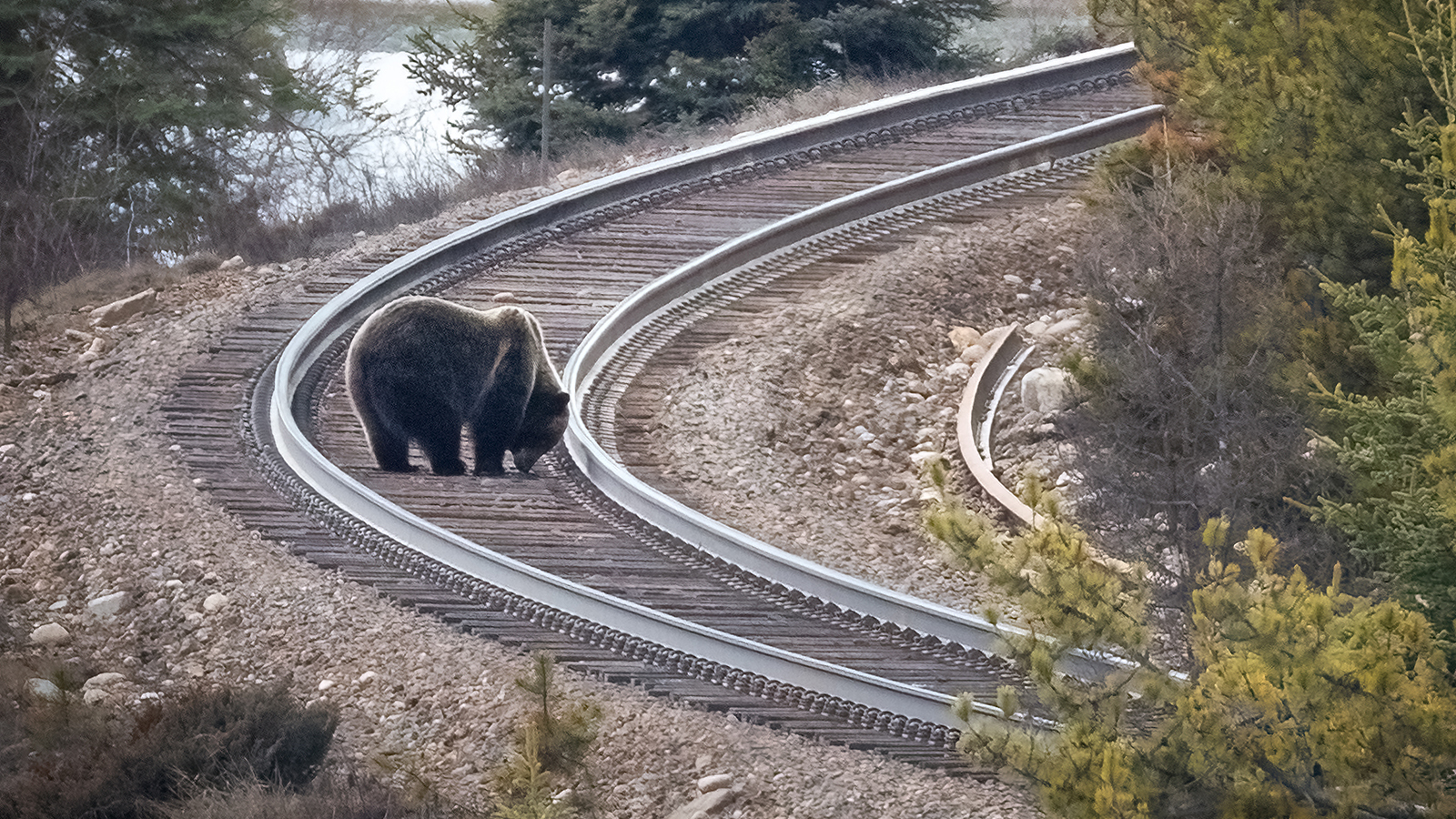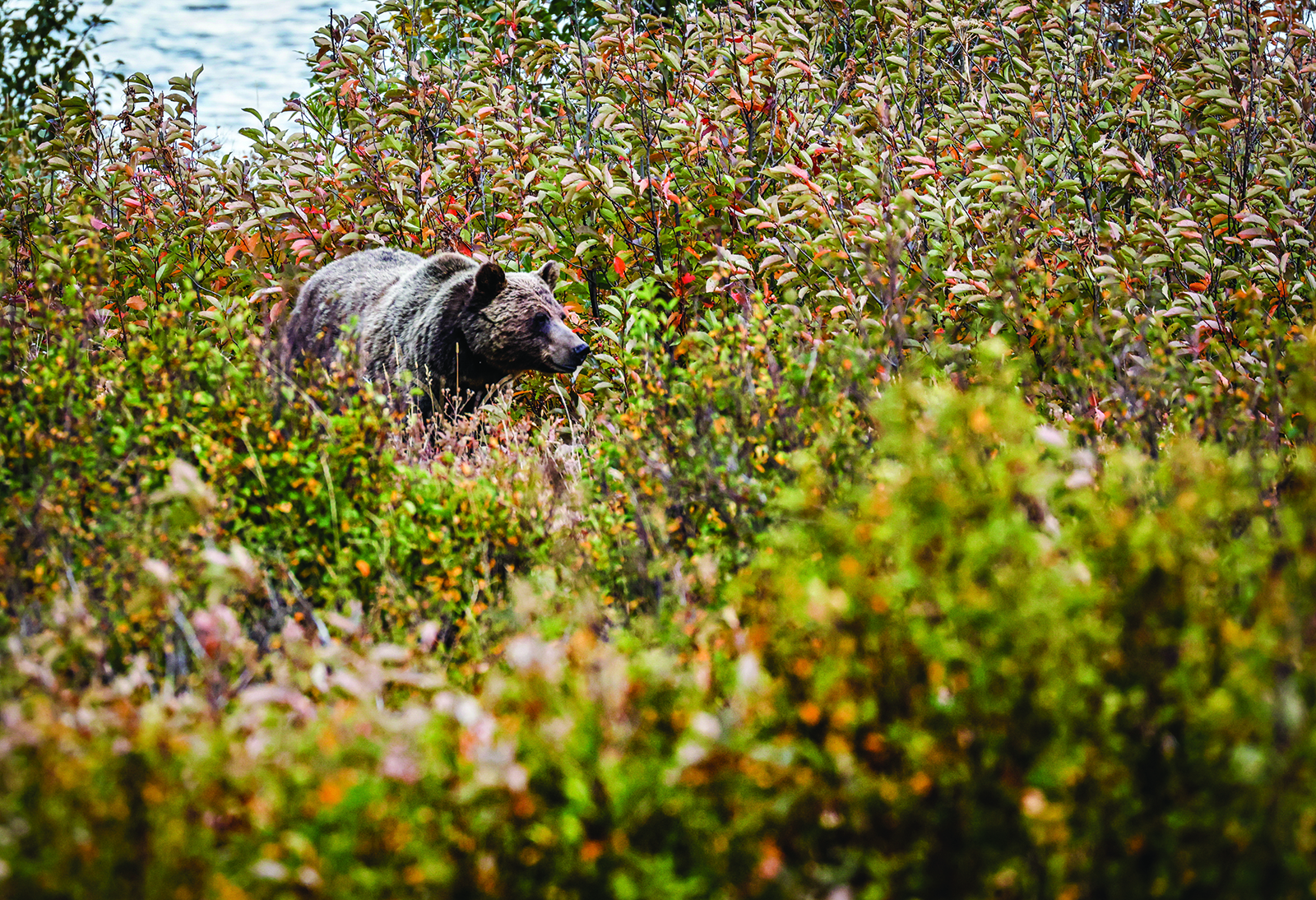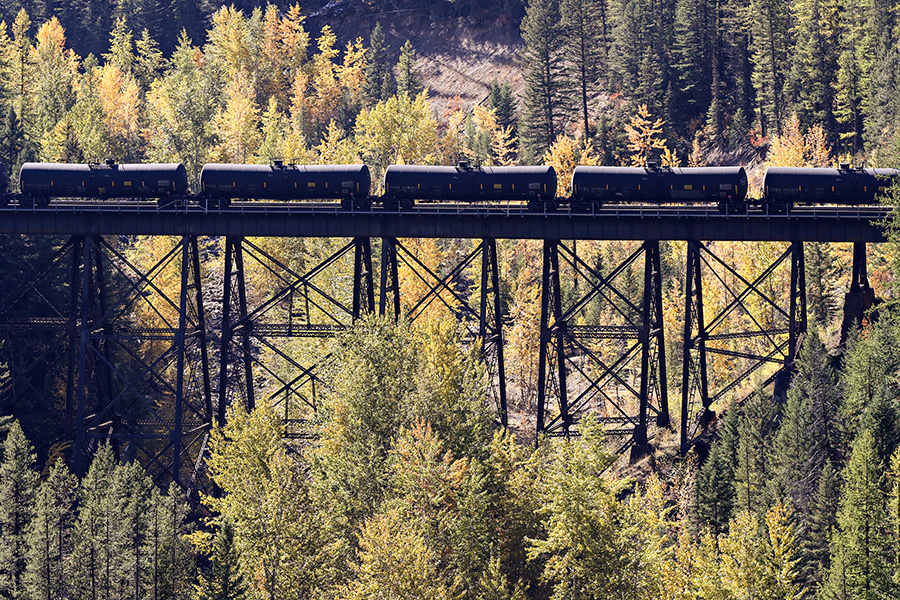Welcome to DU!
The truly grassroots left-of-center political community where regular people, not algorithms, drive the discussions and set the standards.
Join the community:
Create a free account
Support DU (and get rid of ads!):
Become a Star Member
Latest Breaking News
Editorials & Other Articles
General Discussion
The DU Lounge
All Forums
Issue Forums
Culture Forums
Alliance Forums
Region Forums
Support Forums
Help & Search
Montana
Related: About this forumDrunk Grizzlies Keep Getting Hit By Trains In Montana
Drunk Grizzlies Keep Getting Hit By Trains In MontanaSince 1980, 63 grizzlies have been hit by trains and killed along a section of railroad near Glacier National Park. Many died because they got drunk on fermented grain spilled from railcars and couldn’t move fast enough to outrun the trains.
Mark Heinz
November 04, 2023
5 min read

A grizzly bear grazes for spilt grain on the train tracks in Banff National Park, Alberta, Canada. Since 1980 in Montana, 68 grizzlie, many "drunk" on fermented grain, have been killed by trains. (Getty Images)
Getting “drunk” on fermented grain has killed dozens of grizzly bears along a treacherous stretch of rail line near Glacier National Park, Montana.
Since 1980, 63 bears have been killed along a stretch of rail line that goes over Marias Pass and the Great Bear Wilderness, according to reports from state and federal wildlife agencies. The worst year on record was 2019, when eight grizzlies were killed by trains, and three have been killed so far this year.
Many of them likely died during a “drunken attempt” to outrun the trains, a Wyoming bear expert said. … Grain spilled from railcars along the tracks can be a tempting treat for bears, retired federal ecologist Chuck Neal of Cody told Cowboy State Daily.
With enough moisture from snow and rain, “the spilled grain actually ferments in place and becomes a de facto brewery,” he said.
{snip}
4 replies
 = new reply since forum marked as read
Highlight:
NoneDon't highlight anything
5 newestHighlight 5 most recent replies
= new reply since forum marked as read
Highlight:
NoneDon't highlight anything
5 newestHighlight 5 most recent replies
Drunk Grizzlies Keep Getting Hit By Trains In Montana (Original Post)
mahatmakanejeeves
Nov 2023
OP
The Cowboy State Daily plays the story as comic. There's a much more serious side.
mahatmakanejeeves
Nov 2023
#3
mahina
(20,246 posts)1. Perfect.
I made the very big mistake of reading Reddit news tonight
Seriously, do not recommend.
Now, drunken bears getting squished by trains - poor things.
good night.
liberalla
(10,750 posts)2. This is sad... couldn't they make their containers more safe?
Less likely to spill/spread the grain? Higher sides on the cars, or tarps covering them? Something that actually "contains" the grain?
That's a lot of bears dying.
mahatmakanejeeves
(67,796 posts)3. The Cowboy State Daily plays the story as comic. There's a much more serious side.
As Grizzly Bear Train Mortalities Spike, BNSF Mitigation Funds are Years Overdue
Another spate of train-caused grizzly bear deaths in northwest Montana has drawn attention to an overdue federal conservation plan that includes $2.6 million in funding from BNSF Railway to mitigate bear-human conflicts on the landscape
BY TRISTAN SCOTT
OCTOBER 4, 2023

A grizzly bear in the Northern Continental Divide Ecosystem seen on Sept. 12, 2021. Hunter D’Antuono | Flathead Beacon
On Sept. 18, Justine Vallieres was setting traps to capture a pair of food-conditioned grizzly bears breaking into cabins up the North Fork when she got word that a third bear, also a grizzly, had been killed on the train tracks near Stryker, clear across the Whitefish Range. As the wildlife conflict management specialist for Montana Fish, Wildlife and Parks (FWP) in northwest Montana, Vallieres remembers it as one of countless instances she wishes she could have been in two places at once. ... Lacking that superpower, the bear biologist hopped into her government pickup truck and drove two hours over the mountain pass to the site of the train strike, where she found a dead 25-year-old male grizzly and set to work documenting the federally protected bear’s death.
“We get stretched thin,” Vallieres said. “Up here in northwest Montana, we have the highest density of bear-human conflicts in the state, and we’re putting in 60- to 80-hour work weeks responding to them. So yeah, having to go investigate a grizzly bear killed on the train tracks adds to the burden and distracts us from our efforts to keep bears and humans safe.”
Ten days earlier, on Sept. 8, Vallieres was wrapping up her workday around dark when she received a mortality signal from a 10-year-old radio-collared sow grizzly whose coordinates help wildlife officials monitor population trends. Its location? A BNSF Railway Company trestle spanning the Flathead River near Coram. ... “When I saw that the mortality sensor was near the train tracks, I knew I had to get there as soon as possible,” Vallieres said. “We’ve had a few on that train trestle in Coram. It’s so high up that they either try to jump off or outrun the train. And they can’t outrun the train. It would be nice if BNSF would install some motion-sensor alarms across the trestles to scare the bears so they won’t keep trying to cross them.”
For decades, the freight trains trundling over Marias Pass toward Glacier National Park and the Great Bear Wilderness along a 206-mile stretch of tracks between Shelby and Trego have posed a threat to the grizzlies living there, particularly when a derailment causes a grain spill, or a train-killed deer or livestock carcass draws the bears onto the busy tracks. And for decades, a host of state, federal and tribal wildlife management agencies, as well as non-governmental organizations and conservation groups, have worked with the railroad to mitigate the hazards to threatened and endangered species like grizzlies, with varying degrees of effectiveness.

A BNSF Railway oil train crosses a trestle along the Middle Fork Flathead River. Beacon file photo
{snip}
Another spate of train-caused grizzly bear deaths in northwest Montana has drawn attention to an overdue federal conservation plan that includes $2.6 million in funding from BNSF Railway to mitigate bear-human conflicts on the landscape
BY TRISTAN SCOTT
OCTOBER 4, 2023
A grizzly bear in the Northern Continental Divide Ecosystem seen on Sept. 12, 2021. Hunter D’Antuono | Flathead Beacon
On Sept. 18, Justine Vallieres was setting traps to capture a pair of food-conditioned grizzly bears breaking into cabins up the North Fork when she got word that a third bear, also a grizzly, had been killed on the train tracks near Stryker, clear across the Whitefish Range. As the wildlife conflict management specialist for Montana Fish, Wildlife and Parks (FWP) in northwest Montana, Vallieres remembers it as one of countless instances she wishes she could have been in two places at once. ... Lacking that superpower, the bear biologist hopped into her government pickup truck and drove two hours over the mountain pass to the site of the train strike, where she found a dead 25-year-old male grizzly and set to work documenting the federally protected bear’s death.
“We get stretched thin,” Vallieres said. “Up here in northwest Montana, we have the highest density of bear-human conflicts in the state, and we’re putting in 60- to 80-hour work weeks responding to them. So yeah, having to go investigate a grizzly bear killed on the train tracks adds to the burden and distracts us from our efforts to keep bears and humans safe.”
Ten days earlier, on Sept. 8, Vallieres was wrapping up her workday around dark when she received a mortality signal from a 10-year-old radio-collared sow grizzly whose coordinates help wildlife officials monitor population trends. Its location? A BNSF Railway Company trestle spanning the Flathead River near Coram. ... “When I saw that the mortality sensor was near the train tracks, I knew I had to get there as soon as possible,” Vallieres said. “We’ve had a few on that train trestle in Coram. It’s so high up that they either try to jump off or outrun the train. And they can’t outrun the train. It would be nice if BNSF would install some motion-sensor alarms across the trestles to scare the bears so they won’t keep trying to cross them.”
For decades, the freight trains trundling over Marias Pass toward Glacier National Park and the Great Bear Wilderness along a 206-mile stretch of tracks between Shelby and Trego have posed a threat to the grizzlies living there, particularly when a derailment causes a grain spill, or a train-killed deer or livestock carcass draws the bears onto the busy tracks. And for decades, a host of state, federal and tribal wildlife management agencies, as well as non-governmental organizations and conservation groups, have worked with the railroad to mitigate the hazards to threatened and endangered species like grizzlies, with varying degrees of effectiveness.
A BNSF Railway oil train crosses a trestle along the Middle Fork Flathead River. Beacon file photo
{snip}
MontanaMama
(24,592 posts)4. I know a couple of engineers for the former Montana Rail Link
now BNSF. It is absolute trauma for them when they hit a grizzly.
Speaking of bears…one of our local grizzlies was hit by a vehicle and killed just outside of town a couple weeks ago. The bear’s name was Dick, he weighed 582 pounds and he was around 20 years old when he died. We’re all really sad about him dying this way.